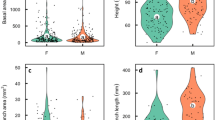Summary
Amaranthus and several other wind-pollinated species of plants are used to test some of the theoretical models of relative reproductive effort towards the male and female sexes. Consistent with these models, in self-compatible, monoecious Amaranthus, Chenopodium, Digitaria, Setaria, and Lepidium, female effort represented over 90% of the total reproductive effort. Also consistent with predictions, Lolium, a self-incompatible wind-pollinated species, was found to have about equal male and female effort. A method is described here that should prove useful in quantifying male and female effort in both wind and insect-pollinated species of plants.
Similar content being viewed by others
References
Allard, R.W.: Genetic systems associated with colonizing ability in predominantly self-pollinated species. In: The Genetics of Colonizing Species. (Baker, H.G. and G.L. Stebbins eds.), New York Academic Press 1965
Baker, H.G.: Characteristics and modes of origin of weeds. In: The Genetics of Colonizing Species. (Baker, H.G. and G.L. Stebbins eds.), New York Academic Press 1965
Daly, M.: The cost of mating. American Naturalist 112, 771–774. (1978)
Fisher, R.A.: The Genetical Theory of Natural Selection. Dover, New York (1958)
Hamilton, W.D.: Extraordinary sex ratios. Science 156, 447–488 (1967)
Lloyd, D.G., Webb, C.J.: Secondary sex characteristics in seed plants. The Botanical Review 43, 117–216 (1977)
Maynard Smith, J.: What use is sex. Journal of Theoretical Biology 30, 319–335 (1971a)
Maynard Smith, J.: The origin and maintenance of sex. In: Group Selection. (Williams, G.C. ed.), Aldine Atherton Inc., Chicago 1971b
Murray, M.J.: The genetics of sex determination in the family Amaranthaceae. Genetics 25, 409–431 (1940)
Nettancourt, D. de: Incompatibility in Angiosperms. Springer-Verlag, Berlin (1977)
Sauer, J.D.: Recent migration and evolution of the dioecious amaranths. Evolution 11, 11–31 (1957)
Sauer, J.D.: The dioecious Amaranthus: A new species name and major range extensions. Nadrono 22, 426–434 (1972)
Stebbins, G.L.: Self-fertilization and population variability in higher plants. American Naturalist 91, 337–354 (1957)
Williams, G.C.: Sex and Evolution. Princeton University Press, Princeton (1975)
Author information
Authors and Affiliations
Rights and permissions
About this article
Cite this article
Lemen, C. Allocation of reproductive effort to the male and female strategies in wind-pollinated plants. Oecologia 45, 156–159 (1980). https://doi.org/10.1007/BF00346454
Received:
Issue Date:
DOI: https://doi.org/10.1007/BF00346454




